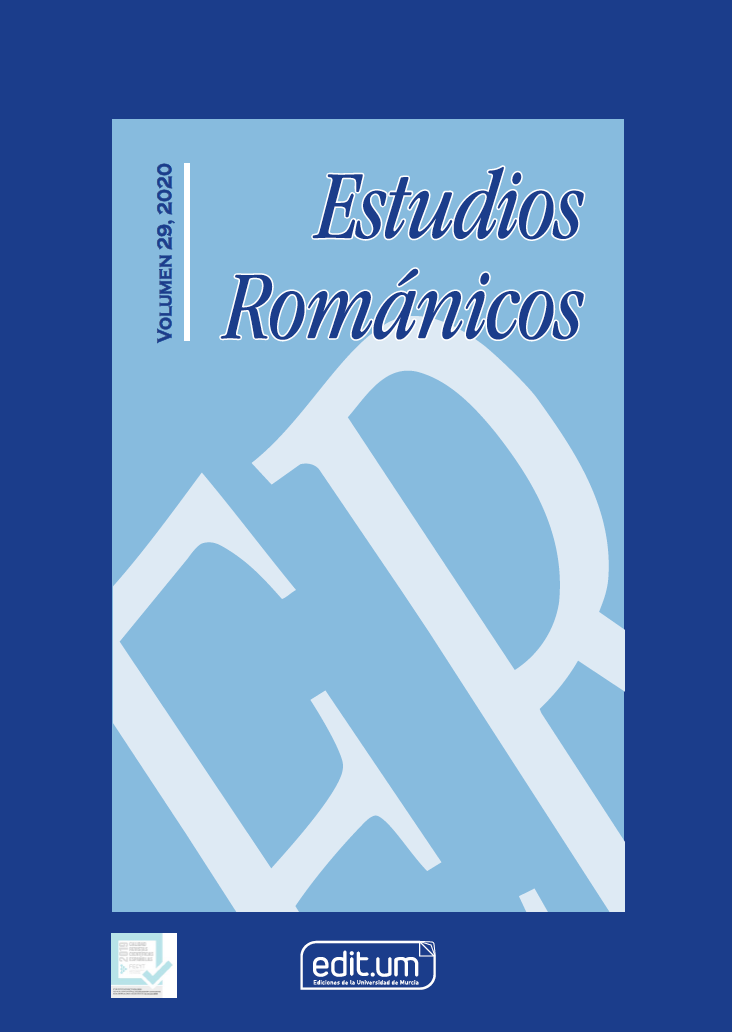Datation of the Lybro of magyka (Ms. 5-2-32, Colombina Library, Sevilla)
Abstract
The objective of this work is to identify the approximate date of the production of the text of the manuscript Lybro de magyka, the third part of a work on astrology, in Spanish, purchased by Hernando Colón in 1527, which is preserved today in the Biblioteca Colombina, Seville, Spain, under the registration Ms. 5-2-32. Our hypothesis is that the text was written between the thirteenth and sixteenth centuries, and is a copy of a Catalan translation. Therefore, the theoretical basis is constituted by works of internal and external history of the Spanish language that bring representative characteristics of the medieval Spanish. The characteristics below allow to elaborate criteria for the analysis that would verify or not the initial hypothesis: 1) the formation of adverbs with the suffix -mientre ; 2) the masculine ones made in -a that adopt feminine concordance; 3) the change of the copulative et to y; The results show that the language of the manuscript probably dates from the fifteenth century, which is in accordance with the hypotheses of authorship proposed by the works on the Lybro de Magyka so far. Thus, the present study contributes to the reconstruction of the history of the codex and to the studies about the Spanish language.
Downloads
-
Abstract522
-
PDF (Español (España))340
References
ALONSO, Martin (1964): Evolución sintáctica del español. Madrid: Aguilar.
ALVAR, Manuel; POTTIER, Bernard (1983): Morfología histórica del español. Madrid:
Gredos.
ANTHONY, Laurence (2019): AntConc (Version 3.5.8) [Computer Software]. Tokyo, Japan: Waseda University.[http://www.laurenceanthony.net/software; 19 de marzo 2019].
BEAUJOUAN, Guy (1971): “L’astronomie dans la Péninsule Ibérique a la fin du Moyen Âge”. Revista da Universidade de Coimbra, 24, 13-22.
BISCHOFF, Bernhard (1990): Latin Paleography: Antiquity and the Middle Ages. Cambridge: Cambridge University Press.
CANO AGUILAR, Rafael (2005): El español a través de los tiempos. Madrid: Arco/Libro.
CARVALHO, Joaquim de (1926): Excerpta bibliographica ex Biblioteca Columbina. Coimbra: s/e. [http://www.joaquimdecarvalho.org/artigos/artigo/247-Excerpta-Bibliographica-Ex-Bibliotheca-Columbina; 2 diciembre 2018]
Catálogo Informatizado de la Biblioteca Colombina (2018) [https://opac.icolombina.es/opac/abnetcl.exe/O7002/ID44bc4630/NT1; 27 de febrero de 2019]
COROMINAS, Joan (1954): Diccionario crítico etimológico de la lengua castellana. Madrid: Gredos. v. 3 y 4.
CNDHE: Corpus del Nuevo diccionario histórico (2013). Instituto de Investigación Rafael Lapesa de la Real Academia Española. [http://web.frl.es/CNDHE; 31 de junio de 2018]
DÍEZ DE REVENGA TORRES, Pilar; GARCÍA DÍAZ, Pilar (1988-1989): “Problemas
lingüísticos en los copistas medievales, II”. Anales de Filología Hispánica,
, 59-73.
DÍEZ DE REVENGA TORRES, Pilar (2001): “La importancia de la documentación
en el estudio de un estado de lengua en la Edad Media”. Cahiers de linguistique
et de civilisation hispaniques medievales, 24, 27-34. [https://www.persee.
fr/doc/cehm_0396-9045_2001_num_24_1_1166; 25/06/2019]
DLE: Real Academia Española (2014). Diccionario de la lengua española. [https://dle.rae.es; 05 mayo 2019]
DUCHOWNY, Aléxia (2010). De magia (Ms. Laud Or. 282, Bodleian Library): descrição
codicológica. Caligrama: revista de estudos românicos, 5, 9-109. [http://www.
periodicos.letras.ufmg.br/index.php/caligrama/article/view/35; 25/06/2019]
DUCHOWNY (2020, inédito). Edición del Lybro de magyka (Ms. 5-2-32, Biblioteca
Colombina, Sevilla).
DUCHOWNY Y PEREIRA (2020a, inédito). Descripción del Lybro de magyka (Ms.
-2-32, Biblioteca Colombina, Sevilla).
(2020b, inédito) Descripción paleográ!ca del Lybro de magyka (Ms. 5-2-32,
Biblioteca Colombina, Sevilla).
GONZÁLEZ LLUBERA, Ignacio (1952): “Two old astrological texts in Hebrew characters”. Romance Philology, 6, 267-272.
HANSSEN, Federico (1945): Gramática Histórica de la Lengua Castellana. Buenos Aires: El Ateneo.
LAPESA, Rafael (1981): Historia de la lengua española. Madrid: Gredos.
MENÉNDEZ PIDAL, Ramón (1989): Manual de gramática histórica española. Madrid: Espasa-Calpe.
MORALA RODRÍGUEZ, José (2002): De la complejidad interna del castellano en
Castilla (y León). En SARALEGUI, C.; CASADO, M. (Eds.), Pulchre, bene,
recte. Estudios en homenaje al Prof. Fernando González Ollé, Eunsa, Pamplona,
-969. [http://jrmorala.unileon.es/biblioteca/HGOlle.pdf; 25/06/2019]
PENNY, Ralph (1995): A history of the Spanish language. Cambridge: Cambridge University
Press.
PENNY, Ralph (2014): Gramática histórica del español. Barcelona: Ariel.
SÁ, Artur M. de (1960): “A próxima edição de três traduções portuguesas inéditas do
século XV”. Boletim Internacional de Bibliogra!a Luso-brasileira. Lisboa, 1
(1), 562-585.
SÁ, Artur M. de (1960): “A próxima edição de três traduções portuguesas inéditas do século XV”. Boletim Internacional de Bibliografia Luso-brasileira. Lisboa, 1 (1), 562-585.
SILVA, Luciano P. (1924): “O astrólogo João Gil e o ‘Livro da montaria’”. Lusitânia: revista de estudos portugueses, 2, 41-50.
Copyright (c) 2020 Estudios Románicos

This work is licensed under a Creative Commons Attribution-NonCommercial-ShareAlike 4.0 International License.
Las obras que se publican en esta revista están sujetas a los siguientes términos:
1. El Servicio de Publicaciones de la Universidad de Murcia (la editorial) conserva los derechos patrimoniales (copyright) de las obras publicadas, y favorece y permite la reutilización de las mismas bajo la licencia de uso indicada en el punto 2.
2. Las obras se publican en la edición electrónica de la revista bajo una licencia Creative Commons Reconocimiento-NoComercial-SinObraDerivada 3.0 España (texto legal). Se pueden copiar, usar, difundir, transmitir y exponer públicamente, siempre que: i) se cite la autoría y la fuente original de su publicación (revista, editorial y URL de la obra); ii) no se usen para fines comerciales; iii) se mencione la existencia y especificaciones de esta licencia de uso.
3. Condiciones de auto-archivo. Se permite y se anima a los autores a difundir electrónicamente las versiones pre-print (versión antes de ser evaluada) y/o post-print (versión evaluada y aceptada para su publicación) de sus obras antes de su publicación, ya que favorece su circulación y difusión más temprana y con ello un posible aumento en su citación y alcance entre la comunidad académica. Color RoMEO: verde.












